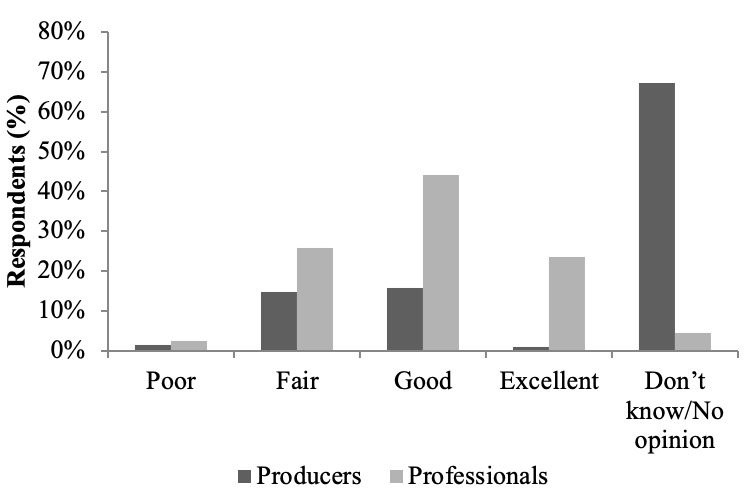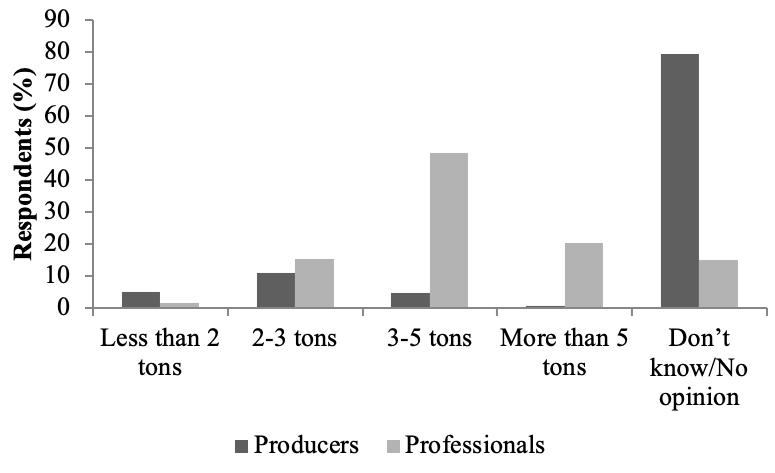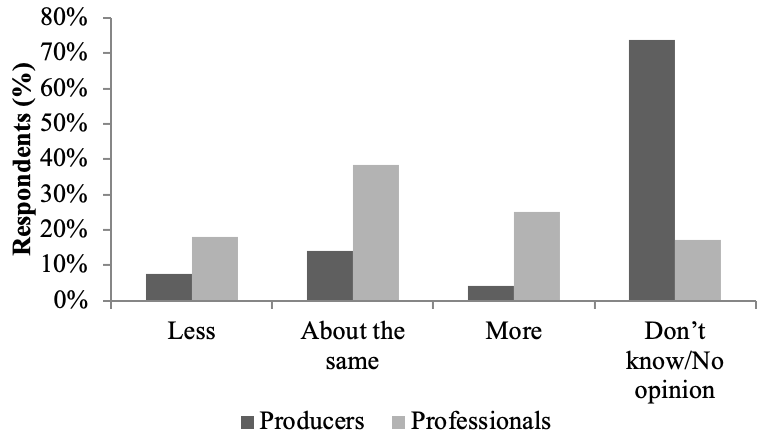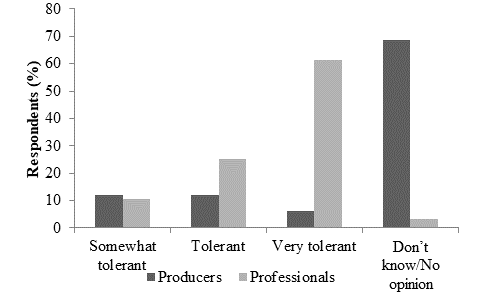 |
December 2019
|
December 2019 // Volume 57 // Number 6 // Research In Brief // v57-6rb4
Identifying Barriers to Forage Innovation: Native Grasses and Producer Knowledge
Abstract
Adoption of native warm-season grasses (NWSGs) in the tall fescue belt is limited despite studies documenting the potential contribution of these forages to profitable beef production. On the basis of two surveys conducted in Tennessee, a survey of beef producers and a survey of agricultural professionals, we evaluated perceptions of NWSG forages and how those perceptions could influence their adoption. Although agricultural professionals were more familiar with NWSGs than producers, both populations had limited knowledge regarding these forages, indicating that additional Extension education is needed. Our results provide useful guidance for developing NWSG forage educational programs for producers and agricultural professionals.
Introduction
Cattle production in the tall fescue (TF) belt, an area in the humid eastern United States that generally lies south of glaciation and north of the Gulf Coastal Plain, is dominated by forage-based operations (McBride & Mathews, 2011). As a cool-season grass, TF grows from early March to June with additional growth from the end of September to November. Although it is adaptable, easy to establish, and persistent under adverse conditions (Stuedemann & Hoveland, 1988), TF becomes semidormant during summer, and, consequently, forage productivity and quality decline (Volenec & Nelson, 2007). Furthermore, most TF is infected with an endophytic fungus that negatively affects cattle (i.e., causing elevated body temperature, lower conception rates, and reduced average daily gain), particularly during summer (Looper et al., 2010; Roberts & Andrae, 2004). TF grows on approximately 37 million ac and impacted 26% of all beef cows that calved in 2011 (Bussard & Aiken, 2012); however, producers' losses resulting from endophyte toxicity have been estimated at $1 billion annually (Strickland et al., 2011).
One option for mitigating reduced summer forage production is to rotate cattle to warm-season grasses (WSGs). Several WSG forages are suited for the TF belt, including native WSGs (NWSGs) (e.g., switchgrass, big bluestem, indiangrass, eastern gamagrass), nonnative perennial WSGs (e.g., bermudagrass), and annual WSGs (e.g., crabgrass). Because WSGs grows from mid-May through September, these forages can increase grazing days and provide options to rest TF during summer, making their use an effective complement to TF-dominated grazing systems.
Several studies have addressed animal performance on WSGs in the region and have shown that steers grazing WSGs have positive gains (Backus et al., 2017; Burns & Fisher, 2013; Burns, Mochrie, & Timothy, 1984). Studies also have involved comparison of animal and forage production from annual WSGs and NWSGs (Tracy, Maughan, Post, & Faulkner, 2010) and from bermudagrass and NWSGs (Burns & Fisher, 2013; Burns et al., 1984). These studies indicated that NWSGs produce more forage and support higher beef gains than the other WSG options. Furthermore, economics studies have indicated positive net returns from grazing animals on NWSGs (Lowe et al., 2015; Lowe et al., 2016). Another benefit of using NWSGs is that these grasses are more drought and heat tolerant than cool-season grasses (Brown, 1999).
Despite these findings, TF belt producers have not widely adopted NWSGs, a circumstance that might be explained by producers' perceptions about these forages. For instance, Wen, Ignosh, Parrish, Stowe, and Jones (2009) reported that farmers in Virginia were reluctant to plant switchgrass because they were not familiar with it. Therefore, we examined Tennessee beef producers' perceptions of NWSGs. Additionally, we surveyed agricultural professionals about their perceptions of NWSGs. The survey results can guide educational efforts on NWSG use in Tennessee and, more broadly, the TF belt.
Method
We developed our sample frame by coordinating with the U.S. Department of Agriculture (USDA) National Agricultural Statistics Service (NASS) to randomly select 1,620 Tennessee beef cattle producers with herd sizes between 20 and 499 head. We used respondent debriefing and cognitive interviewing to pretest the producer survey in February 2011 (Hughes, 2004). We distributed the draft questionnaire by mail to 80 beef cattle producers who were participants in the University of Tennessee Extension's Master Beef Producers program. Instructions directed respondents to answer the survey questions and, using a one-page feedback form and the questionnaire itself, identify any wording, questions, or survey instructions that were unclear or confusing and offer comments. We then conducted interviews with five pretest respondents. We made some adjustments to question wording but did not remove, add, or relocate any questions on the basis of pretest results.
In surveying the sample of 1,620 beef producers, we employed a three-wave survey design following the general guidelines of Dillman, Smith, and Christian (2009), with the first and third waves being delivery of the survey instrument, a letter of introduction, and a prepaid return envelope. The second wave was a postcard reminder. We spaced mailings 14 days apart, with the first mailing occurring on April 26, 2011. We received completed surveys between May 3, 2011, and August 18, 2011. The response rate for the survey was 40%, according to application of the American Association for Public Opinion Research (2009) response rate calculation.
In addition, we sent another survey to University of Tennessee/Tennessee State University Extension agents (n = 231), Natural Resources Conservation Service field staff (n = 121), soil and water conservation district field staff (n = 118), and Tennessee Wildlife Resources Agency private lands biologists (n = 5) to assess their perceptions of NWSG for forage production. Four individuals opted out of the survey, and 52 emails bounced, leaving a sampling frame of 419 agricultural professionals (hereafter referred to as "professionals"). A total of 252 responses were returned (60% response rate), and 222 were usable responses (53% response rate). We administered this survey in February 2014 and followed the three-wave survey design. We asked professionals many of the same questions we had asked the producers with a few differences that reflected their role as advisors rather than producers, and we asked about their perceptions of producers' knowledge of NWSGs. We report descriptive statistics for beef producers' and professionals' perceptions of NWSGs.
Results and Discussion
Average age of respondents in the producer survey was 61 years, and 27% of respondents had 4-year college or university degrees. Most respondents were cow-calf producers (88%), average herd size was 30 head, and 10% of respondents had stocker operations averaging 30 head. Average farm size was 100 ac of pasture and 62 ac of hay. These data closely align with averages for the state: operator age, 59 years; beef herd size, 29 cows; and farm size, 160 ac (USDA NASS, 2012).
Most producers responded that they were somewhat interested, interested, or very interested in improving summer forage production, and professionals perceived that 97% of producers were in one of those three categories (Table 1). Our producer survey was administered during spring and following a summer with almost no drought in Tennessee (i.e., 2010). Most producers, but only 5% of professionals, were not familiar with NWSGs (Table 1). Conversely, only 5% of producers but slightly more than half of the professionals were familiar or very familiar with NWSGs (Table 1). Furthermore, professionals perceived that fewer producers were not familiar with NWSGs and that more producers were somewhat familiar with NWSGs than actually was the case (Table 1).
| Survey component | Not at all interested/familiar | Somewhat interested/familiar | Interested /familiar | Very interested/familiar |
|---|---|---|---|---|
| How interested are you in improving summer forage production? | ||||
| Producers | 17% | 30% | 31% | 22% |
| Prof_perception | 3% | 36% | 48% | 13% |
| How familiar are you with native warm-season grasses as a forage? | ||||
| Producers | 67% | 29% | 4% | 1% |
| Professionals | 5% | 39% | 35% | 22% |
| Prof_perception | 32% | 62% | 4% | 1% |
Producers and professionals were able to indicate that they had no opinion or did not know enough to answer a question. Given that few producers had adopted NWSGs and most were not familiar with NWSGs, many producer responses fell into this category. For example, most of the producers stated that they did not know or had no opinion about the quality of NWSGs (Figure 1). Among producers who expressed an opinion, most selected fair or good quality (Figure 1). Professionals were far more likely to perceive that NWSGs were a good or excellent quality forage (Figure 1), indicating a substantial gap in perspective between the two populations. Furthermore, professionals underestimated producers' opinions of NWSGs; 40% of professionals indicated that producers would consider such forages poor, but only 1% of producers expressed this opinion (Figure 1). Past research has shown gains above 2.0 lb per day for beef animals grown on these forages (Backus et al., 2017; Burns & Fisher, 2013; Keyser et al., 2016; Mosali, Biermacher, Cook, & Blanton, 2013), suggesting that they are of good to excellent quality.
Figure 1.
Producers' and Professionals' Perceptions of the Quality of Native Warm-Season Grass Forages

Very few producers knew how much hay NWSGs could produce, and of the ones who expressed a perception, most believed that these forages would produce 2–3 tn per acre annually (Figure 2). On the other hand, half of the professionals indicated that NWSGs could produce 3–5 tn of hay per acre annually, a level consistent with levels suggested by past studies (Fike et al., 2006; McIntosh et al., 2015). Although most producers expressed no opinion about or did not know how much beef NWSGs would yield compared to TF and bermudagrass, 22% of producers and 56% of professionals, respectively, believed NWSGs would produce the same or less gain (Figure 3). Producers and professionals were much less likely (4% and 25%, respectively) to believe that grazing NWSGs could yield more than grazing TF and bermudagrass. Given that numerous studies have shown NWSGs to produce more forage and higher beef gains than the other WSGs (Backus et al., 2017; Burns & Fisher, 2013; Burns et al., 1984; Lowe et al., 2015; Lowe et al., 2016; Tracy et al., 2010), our findings suggest that producers were not adequately educated about the results of these experimental trials. Furthermore, Burns and Fisher (2013) in conducting one of the few studies that compared a TF-bermudagrass system to NWSGs, found that NWSGs produced more beef per acre than the TF-bermudagrass system. Additionally, producers in our study underestimated NWSGs drought tolerance (Figure 4). On the other hand, a substantial majority of professionals in the study believed that NWSGs were very tolerant of drought (Figure 4), a perception that is supported in the literature (Brown, 1999).
Figure 2.
Producers' and Professionals' Perceptions of Quantity (Tons per Acre) of Hay Produced from Native Warm-Season Grasses

Figure 3.
Producers' and Professionals' Perceptions of Beef Gains from Grazing Native Warm-Season Grasses Compared to Grazing Tall Fescue and Bermudagrass

Figure 4.
Producers' and Professionals' Perceptions of the Drought Tolerance of Native Warm-Season Grasses

We asked both producers and professionals to identify the cost per acre to establish NWSGs (Table 2). Additionally, we asked producers how much they would be willing to spend (out-of-pocket expenses only) to establish a perennial WSG, and we asked professionals about their perceptions of how much producers would be willing to spend to do so (Table 2). For these questions, we used the more general category, WSG, rather than NWSG, because we anticipated a lack of familiarity with the latter. Fully three fourths of producers did not know the cost per acre to establish NWSGs, but among those who did express an opinion, there was a realistic understanding of actual costs (Table 2). Professionals were much more likely to express an opinion than producers and likewise indicated a realistic assessment of costs (Table 2). Among producers, 37% indicated a willingness to spend an amount commensurate with the actual costs of establishing NWSGs (>$76 per acre) (Table 2). Although this figure is less than the 53% who were either interested or very interested in improving summer forage production, it does suggest that there is a substantial subset of producers who are willing to make an investment in improved summer forage production. Professionals overestimated producers' willingness to spend to establish WSGs, indicating that 70% would spend more than $76 per acre, nearly double the actual proportion of producers who would spend that amount (Table 2).
| $ per acre | ||||||
|---|---|---|---|---|---|---|
| Survey component | $0 | $25-$75 | $76-$125 | $126-$175 | More than $175 | Do not know |
| How much does it cost per acre to establish NWSG? | ||||||
| Producers | 1% | 6% | 9% | 7% | 76% | |
| Professionals | 4% | 15% | 34% | 31% | 16% | |
| How much would you be willing to spend to establish perennial WSG? | ||||||
| Producers | 21% | 41% | 25% | 8% | 4% | |
| Prof_perception | 2% | 27% | 46% | 20% | 4% | |
We asked professionals to rate the importance of six potential obstacles to producers' adopting NWSGs (Table 3). Professionals indicated that difficulties associated with establishment of NWSGs (i.e., loss of forage during establishment year and establishment process) were the most serious obstacles (Table 3). Thus, creating science-based content on these topics could be impactful for NWSG adoption. Professionals rated cost as the next greatest obstacle for producers.
| Obstacle |
Not an obstacle 1 |
2 | 3 | 4 |
A significant obstacle 5 |
|---|---|---|---|---|---|
| Establishment difficulties | 1% | 7% | 18% | 29% | 42% |
| Loss of forage for 1 year during establishment | 1% | 3% | 9% | 32% | 54% |
| Cost of conversion | 2% | 6% | 22% | 40% | 29% |
| Increased pasture management requirements | 1% | 4% | 28% | 46% | 21% |
| Possible requirement for rotational grazing | 3% | 14% | 29% | 36% | 17% |
| Lack of winter production | 7% | 16% | 32% | 28% | 16% |
Extension Implications
The results of our study provide a foundation for developing Extension programming for producers and professionals throughout the TF belt. Although our focus was primarily on NWSGs, the results provide insight into information needs regarding warm-season forage production more generally. With respect to NWSGs, there is a susbstantial need for Extension education for beef cattle producers. As a result of our study, we have focused teaching goals for producer workshops on providing improved summer forage production to complement existing TF-dominated pastures in the region. In addition, our findings motivated the development of the Native Grass College by the University of Tennessee. The college is an online, science-based forage management program (http://nativegrasses.utk.edu/curricula.htm) that launched in 2018. More content will be developed in the future on economics and grazing management. The college augments ongoing efforts to conduct on-farm tours where NWSGs have been established. Furthermore, the college will contribute to educating producers, as well as profesionals, interested in improving forage-based agriculture throughout the TF belt. Indeed, despite greater familiarity with NWSGs among professionals, Extension education programs could still benefit them, given that 43% of professionals were unfamiliar or only somewhat familiar with NWSGs. Due to the perceived importance of establishment as a potential barrier to producers' adoption of these forages, ensuring that professionals are trained properly on establishment practices also would be beneficial.
Acknowledgments
The research reported here was supported by U.S. Department of Agriculture, Cooperative State Research, Education, and Extension Service through Tennessee Hatch Project TEN00350, TEN00442, TEN00463, and, in addition, U.S. Department of Agriculture grant NRCS 69-3A75-9-133.
References
American Association for Public Opinion Research. (2009). Standard definitions: Final dispositions of case codes and outcome rates for surveys (6th ed.). Deerfield, IL: Author.
Backus, W. M., Waller, J. C., Bates, G. E., Harper, C. A., Saxton, A., McIntosh, D. W., . . . Keyser, P. D. (2017). Management of native warm-season grasses for beef cattle and biomass production in the Mid-South USA. Journal of Animal Science, 95, 3143–3153.
Brown, R. H. (1999). Agronomic implications of C4 photosynthesis. In R. F. Sage & R. K. Monson (Eds.), C4 plant biology (pp. 473–507). San Diego, CA: Academic Press.
Burns, J. C., & Fisher, D. S. (2013). Steer performance and pasture productivity among five perennial warm-season grasses. Agronomy Journal, 105(1), 113−123.
Burns, J. C., Mochrie, R. D., & Timothy, D. H. (1984). Steer performance from two perennial pennisetum species, switchgrass, and a fescue-'coastal' bermudagrass system. Agronomy Journal, 76, 795–800.
Bussard, J. R., & Aiken, G. E. (2012, January). Number of beef cows exposed toxic fescue: Small or large? American Forage and Grassland Conference Proceedings, Louisville, KY.
Dillmann, D. A., Smith, J. D., & Christian, L. M. (2009). Internet, mail, and mixed-mode surveys: The tailored design method. Hoboken, NJ: John Wiley & Sons.
Fike, J. H., Parrish, D. J., Wolf, D. D., Balasko, J. A., Green, J. T., Jr., Rasnake, M., & Reynolds, J. H. (2006). Switchgrass production for the upper southeastern USA: Influence of cultivar and cutting frequency on biomass yields. Biomass and Bioenergy, 30, 207–213.
Hughes, K. A. (2004). Comparing pretesting methods: Cognitive interview, respondent debriefing, and behavior coding. Research Report Series, Survey Methodology #2004-02. Washington, DC: Statistical Research Division, U.S. Bureau of the Census.
Keyser, P. D., Holcomb, E. D., Lituma, C. M., Bates, G. E., Waller, J. C., Boyer, C. N., & Mulliniks, J. T. (2016). Forage attributes and animal performance from native grass inter-seeded with red clover. Agronomy Journal, 108, 373–383.
Looper, M. L, Reiter, S. T., Williamson, B. C., Sales, M. A., Hallford, D. M., & Rosenkrans, C. F. (2010). Effects of body condition on measures of intramuscular and rump fat, endocrine factors, and calving rate of beef cows grazing common bermudagrass or endophyte-infected tall fescue. Journal of Animal Science, 88(12), 4133–4141.
Lowe, J. K., II, Boyer, C. N., Griffith, A. P., Keyser, P., Bates, G. E., Waller, J., & Backus, W. M. (2015). Profitability of beef and biomass production from native warm season grasses in Tennessee. Agronomy Journal, 107, 1733–1740.
Lowe, J. K., II, Boyer, C. N., Griffith, A. P., Waller, J. C., Bates, G. E., Keyser, P. D., . . . Holcomb, E. D. (2016). The cost of feeding bred dairy heifers on native warm-season grasses and harvested feedstuffs. Journal of Dairy Science, 99(1–10).
McBride, W. D., & Mathews, K., Jr. (2011). The diverse structure and organization of U.S. beef cow-calf farms (EIB-73). Washington, DC: U.S. Department of Agriculture Economic Research Service.
McIntosh, D. W., Bates, G. E., Keyser, P. D., Allen, F. L., Harper, C. A., Waller, J. C., . . . Beeler, J. E. (2015). The impact of harvest timing on biomass yield from native warm-season grass mixtures. Agronomy Journal, 107, 2321–2326.
Mosali, J., Biermacher, J. T., Cook, B., & Blanton, J. (2013). Bioenergy for cattle and cars: A switchgrass production system that engages cattle producers. Agronomy Journal, 105, 960–966.
Roberts, C., & Andrae, J. (2004). Tall fescue toxicosis and management. Crop Management, 3(1). doi:10.1094/CM-2004-042701-MG.
Strickland, J. R., Looper, M. L., Matthews, J. C., Rosenkrans, C. F., Jr., Flythe, M. D., & Brown, K. R. (2011). St. Anthony's fire in livestock: Causes, mechanisms, and potential solutions. Journal of Animal Science, 89, 1603–1626.
Stuedemann, J. A., & Hoveland, C. S. (1988). Fescue endophyte: History and impact on animal agriculture. Journal of Production Agriculture, 1(1), 39–44.
Tracy, B. F., Maughan, M., Post, N., & Faulkner, D. B. (2010). Integrating annual and perennial warm-season grasses in a temperate grazing system. Crop Science, 50, 2171–2177.
U.S. Department of Agriculture National Agricultural Statistics Service. (2012). Agricultural census. Retrieved from https://www.agcensus.usda.gov/Publications/2012/Full_Report/Volume_1,_Chapter_1_State_Level/Tennessee/
Volenec, J. J., & Nelson, C. J. (2007). Physiology of forage plants. In R. F. Barnes, D. A. Miller, & C. J. Nelson (Eds.), Forages: The science of grassland agriculture: Vol. II (pp. 37–52). Ames, IA: Blackwell Publishing.
Wen, Z., Ignosh, J., Parrish, D., Stowe, J., & Jones, B. (2009). Identifying farmers' interest in growing switchgrass for bioenergy in southern Virginia. Journal of Extension, 47(5), Article 5RIB7. Available at: https://www.joe.org/joe/2009october/rb7.php




